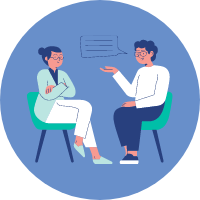Depression is a nuanced mental health condition that affects millions of people worldwide. It’s not just feeling sad or down; it’s a persistent feeling of despair, hopelessness, and disinterest that can deeply impact daily living. Fortunately, there are several therapeutic interventions available, each tailored to address the specific needs and experiences of individuals. In this blog, we will delve into the most effective types of therapy for depression, guiding you through their distinct approaches and benefits.
Contents
What Are The Different Types Of Therapy For Depression?
 Depression is a complex and multifaceted condition. Fortunately, a range of therapeutic modalities has been developed to help individuals navigate and manage their symptoms. Here’s an overview of the different types of therapy for depression:
Depression is a complex and multifaceted condition. Fortunately, a range of therapeutic modalities has been developed to help individuals navigate and manage their symptoms. Here’s an overview of the different types of therapy for depression:
Cognitive Behavioral Therapy (CBT)
Cognitive Behavioral Therapy, commonly referred to as CBT is one of the most widely practiced and researched forms of therapy for depression. At its core, CBT operates on the principle that our thoughts, feelings, and behaviors are interconnected. Negative or distorted thought patterns can lead to depressive feelings, which in turn can influence our behaviors.
The primary aim of CBT is to identify these harmful thought patterns and replace them with healthier, more constructive ones. Techniques such as journaling can help individuals become more aware of their automatic thoughts. Over time, CBT can provide individuals with practical skills to manage their depression and reduce the risk of relapse.
Interpersonal Therapy (IPT)
Interpersonal Therapy, or IPT, is grounded in the idea that interpersonal relationships and life transitions play a significant role in influencing one’s mood. Depression, according to IPT, often arises from or is exacerbated by challenges in our relationships or changes in social roles. These challenges might include unresolved grief, role transitions (like becoming a parent or retiring), and relationship disputes.
IPT aims to improve communication patterns and build interpersonal problem-solving skills. Through techniques like communication analysis and role play, individuals learn to express their needs, understand the needs of others, and navigate interpersonal conflicts, ultimately leading to improved mood and well-being.
Dialectical Behavior Therapy (DBT)
 Initially developed to treat borderline personality disorder, Dialectical Behavior Therapy (DBT) has proven effective for a variety of conditions, including depression. DBT combines traditional cognitive-behavioral techniques with Eastern mindfulness practices. The therapy emphasizes balancing acceptance and change.
Initially developed to treat borderline personality disorder, Dialectical Behavior Therapy (DBT) has proven effective for a variety of conditions, including depression. DBT combines traditional cognitive-behavioral techniques with Eastern mindfulness practices. The therapy emphasizes balancing acceptance and change.
Individuals are taught to accept their feelings and situations (mindfulness) while also learning skills to change negative behaviors and thought patterns. The core modules in DBT include:
- mindfulness (being present at the moment)
- distress tolerance (handling emotional crises)
- emotional regulation (modulating emotional responses)
- and interpersonal effectiveness (navigating conflicts and requests)
Psychodynamic Therapy
Rooted in the theories of psychoanalysis, psychodynamic therapy seeks to uncover the unconscious conflicts and past experiences that influence current behavior and feelings. It operates on the belief that unresolved issues from childhood or past traumatic events can manifest as depression in adulthood. In psychodynamic therapy, individuals are encouraged to explore and discuss past events, emotions, and memories, even if they might seem unrelated to their current mood.
Techniques such as free association, where individuals express thoughts without censorship and dream analysis, where dreams are interpreted for underlying conflicts, are commonly used. Through this deep introspection, individuals gain insight into the root causes of their depression, which can be therapeutic and transformative.
Mindfulness-Based Cognitive Therapy (MBCT)
MBCT is a therapeutic approach that blends traditional CBT with mindfulness strategies. It’s particularly designed to prevent the recurrence of depression in individuals who have recovered but remain at risk for relapse. The therapy teaches individuals to become more aware of their thoughts and feelings and to observe them without judgment.
Techniques used include meditation, where individuals focus on their breath or sensations, and body scans, where attention is directed sequentially through different parts of the body. By cultivating a more mindful approach to life, individuals learn to disengage from automatic, often harmful, cognitive patterns that can trigger a depressive relapse.
Group Therapy
Group therapy offers a unique platform for individuals battling depression to come together and share their experiences. Facilitated by a trained therapist, these sessions provide participants with a sense of community and mutual support. Unlike individual therapy, group therapy capitalizes on the collective wisdom and experiences of its members. The participants can offer and receive feedback, share coping techniques, and understand that they’re not alone in their struggles.
This feeling of solidarity can be immensely therapeutic. Techniques like group discussions allow for open sharing, while role-playing offers a chance to practice new skills in a supportive environment. Experiential exercises may also be employed to deepen understanding and emotional connection among group members.
Narrative Therapy
Narrative therapy operates on the concept that our lives are shaped by the stories we tell about ourselves. Sometimes, these narratives can contribute to feelings of depression. For instance, someone might view themselves as a “failure” or believe they’re “unworthy” based on past events. In narrative therapy, the therapist helps the individual externalize these problematic stories, viewing them as separate from their identity.
By doing so, individuals can then re-author their narratives in more empowering and positive ways. Techniques like externalizing problems (e.g., “the depression” instead of “my depression”) allow individuals to confront these issues without feeling defined by them.
Solution-Focused Brief Therapy (SFBT)
 Unlike some therapeutic modalities that delve deep into past experiences, Solution-Focused Brief Therapy emphasizes the present and the future. The core belief of SFBT is that individuals already possess the skills and resources needed to overcome their challenges; they just need help accessing and applying them. Instead of focusing on the problem, SFBT hones in on solutions. The “miracle question” is a popular technique. In this, individuals imagine what their life would look like if they woke up and the problem was miraculously solved.
Unlike some therapeutic modalities that delve deep into past experiences, Solution-Focused Brief Therapy emphasizes the present and the future. The core belief of SFBT is that individuals already possess the skills and resources needed to overcome their challenges; they just need help accessing and applying them. Instead of focusing on the problem, SFBT hones in on solutions. The “miracle question” is a popular technique. In this, individuals imagine what their life would look like if they woke up and the problem was miraculously solved.
This helps clarify goals and desired outcomes. Exception seeking is another technique, where individuals identify times when the problem wasn’t as pervasive, indicating resilience and potential pathways to change.
Online Therapy or Teletherapy
With the rise of digital technology, online therapy, also known as teletherapy, has become an increasingly popular and viable option for many. This mode of therapy provides increased accessibility for those who might have difficulty attending in-person sessions due to geographical, physical, or time constraints.
It also offers a degree of anonymity, which might be comforting to some individuals. While the techniques employed remain consistent with traditional therapeutic modalities, the digital format requires both the therapist and the client to adapt to the nuances of online communication. This will ensure that the therapeutic alliance remains strong and effective.
So, these are some types of therapy for depression, remember it’s crucial for individuals to consult with mental health professionals. They will help to determine which therapy or combination of therapies is most appropriate for their unique situation.
What Are The Benefits Of Therapy For Depression?
The different types of therapy for depression offer a range of benefits for individuals grappling with depression. Here’s an overview of some of the primary advantages:
- Improved Understanding of Self
Therapy provides a safe space for self-reflection and exploration, enabling individuals to understand the root causes of their depression, be it past traumas, current stressors, or longstanding beliefs and thought patterns.
- Development of Coping Skills
One of the main goals of therapy is to equip individuals with the skills to cope with depressive symptoms and related challenges. This might include stress reduction techniques, problem-solving skills, or strategies to challenge negative thoughts.
- Reduced Feelings of Isolation
Depression can often lead to feelings of loneliness and isolation. Engaging in therapy provides a consistent space where individuals feel heard, understood, and validated.
- Increased Hope and Optimism
By working through issues and making progress in therapy, many individuals experience renewed hope and a more optimistic outlook on life.
- Better Physical Health
Depression not only affects the mind but also has physical implications like sleep disturbances, appetite changes, and decreased energy. Therapy can help alleviate these symptoms, leading to improved overall health.
- Enhanced Relationships
Interpersonal therapy, and other therapeutic approaches as well, often focus on improving social and relational skills. As individuals progress, they may find their relationships with family, friends, and colleagues become more harmonious and fulfilling.
It’s essential to note that the benefits one derives from therapy can vary based on individual needs, the type of therapeutic modality used, and the rapport between the therapist and the client. For optimal outcomes, it’s crucial to find a therapeutic approach and professional that aligns with the individual’s needs and preferences.
How To Find The Right Therapist For Me?
 Finding the right therapist is crucial for effective treatment and a positive therapeutic experience. Here’s a step-by-step guide to help you find a therapist that aligns with your needs and preferences:
Finding the right therapist is crucial for effective treatment and a positive therapeutic experience. Here’s a step-by-step guide to help you find a therapist that aligns with your needs and preferences:
Determine Your Needs
- Type of Therapy: Are you looking for individual therapy, couples counseling, family therapy, or group therapy?
- Specialization: Some therapists specialize in specific areas like trauma, anxiety, depression, or family dynamics. Determine what expertise you’re seeking.
- Modality Preference: Are you more inclined towards CBT, psychodynamic therapy, DBT, or another approach
Consider Logistics
- Location: Do you need a therapist close to your home or workplace? With the advent of online therapy, location may be less of an issue if you’re open to teletherapy.
- Availability: Does the therapist have openings that fit with your schedule?
- Cost: Can you afford their rates? If you’re using insurance, do they accept your plan?
Do Your Research
- Ask for Recommendations: Friends, family, doctors, or other healthcare professionals can provide referrals.
- Online Directories: Websites like TherapyMantra, MantraCare, or TherapyRoute have directories of therapists with profiles detailing their expertise.
- Professional Associations: Organizations like the American Psychological Association or the National Association of Social Workers offer therapist finders.
Check Qualifications
- Ensure the therapist is licensed in your state.
- Look into their education, training, and any additional certifications.
- Check if there are any complaints or disciplinary actions against them.
Initial Contact
- Ask Questions: When you reach out, ask about their experience with issues similar to yours, their therapeutic approach, and any other queries you might have.
- Listen to Your Gut: Your initial interaction can give you a sense of how comfortable you feel with the therapist.
Assess After a Few Sessions
- It might take a few sessions to determine if a therapist is right for you.
- Reflect on whether you feel heard, and understood, and if the therapist respects your values and boundaries.
Remember It’s Okay to Switch
If after several sessions you feel the fit isn’t right, it’s okay to seek a different therapist. Therapeutic fit is essential, and both you and your therapist want the best for your mental health journey.
Lastly, prioritize your comfort and well-being. A strong therapeutic alliance—your working relationship with your therapist—is a significant predictor of positive therapy outcomes. Ensure you feel safe, respected, and understood in your therapeutic environment.
Conclusion
Selecting the right therapist for different types of therapy for depression is a deeply personal journey that requires introspection, research, and, at times, trial and error. It’s essential to prioritize your feelings of comfort and trust in this therapeutic relationship. Remember, therapy is a partnership, and finding the right fit can significantly enhance the effectiveness of the process.
With persistence and the right support, a pathway to better mental health and personal growth awaits. If you are experiencing depression-related issues, Online Depression Counseling at TherapyMantra can help: Book a trial Online therapy session.


